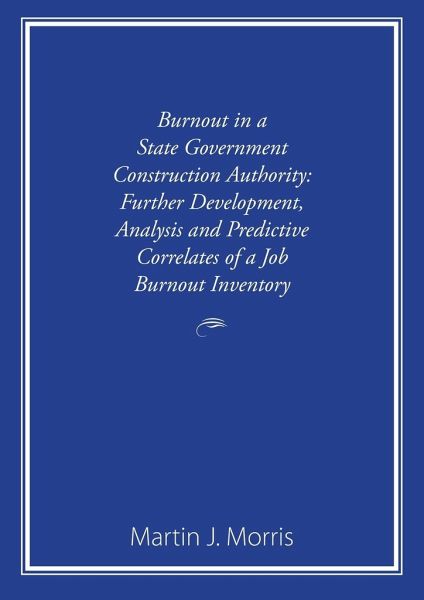
Burnout in a State Government Construction Authority
Further development, analysis and predictive correlates of a job burnout inventory
Versandkostenfrei!
Versandfertig in 1-2 Wochen
15,99 €
inkl. MwSt.

PAYBACK Punkte
8 °P sammeln!
The burnout phenomenon has been extensively studied among human service workers. Although widely acknowledged to be associated with individually and organisationally dysfunctional outcomes, burnout lacks substantial theoretical and empirical foundations. Claims have been made that burnout is not confined to the experience of human service workers but is prevalent among those working in corporate sector organisations: employees of large bureaucracies supposedly being particularly susceptible. Very little empirical evidence exists in support of the foregoing assertions. Ford, Murphy and Edwards ...
The burnout phenomenon has been extensively studied among human service workers. Although widely acknowledged to be associated with individually and organisationally dysfunctional outcomes, burnout lacks substantial theoretical and empirical foundations. Claims have been made that burnout is not confined to the experience of human service workers but is prevalent among those working in corporate sector organisations: employees of large bureaucracies supposedly being particularly susceptible. Very little empirical evidence exists in support of the foregoing assertions. Ford, Murphy and Edwards (1983) concluded that human service workers and corporate sector employees process information about stressful job conditions in different ways. Ford et al. (1983) were unable, owing to the limited size of their sample, to present an analysis of the inventory for any demographic subgroups of human service workers or corporate sector employees. To further establish the efficacy of the J.B.I. and present relevant sociodemographic data, using a 16 item Modified Job Burnout Inventory (M.J.B.I.), including three items to assess expectations of self-efficacy at work, data was collected from 440 female and 720 male employees of a large government sector civil engineering organisation as part of their voluntary participation in a broader enquiry into the Status of Equal Employment Opportunity in the organisation. Subjects were all females in the organisation and a stratified random sample, estimated to be representative, of males. The first two components comprising the factor solution of the M.J.B.I. closely approximated a forced two-factor solution reported by Ford et al.(1983) for corporate sector employees. A significantly smaller proportion of total variance than that reported by Ford et al. (1983) was accounted for by the first two factors of the M.J.B.I. A third factor was revealed describing expectations of self-efficacy at work. Results suggest that the M.J.B.I. may be improved by the addition of items to measure feelings of personal accomplishment at work. Tentative support was found for two models of burnout. Each of these models, one causal and the other developmental, may be further enhanced by more precise operational definition and measurement of constituent variables.














